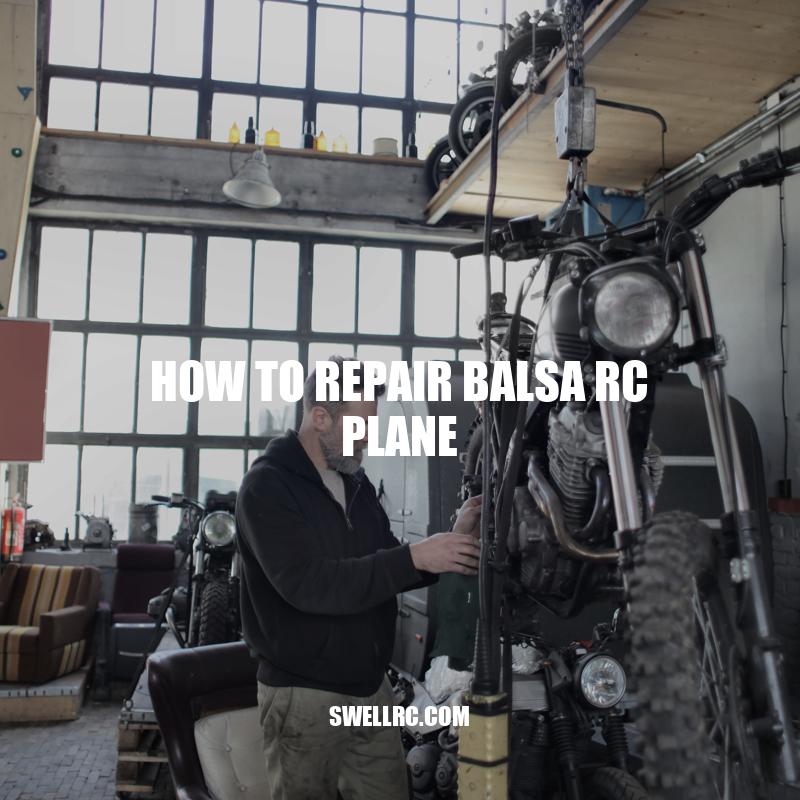Balsa RC Plane Repair: A Guide to Fixing Damage
Balsa wood airplanes are a popular hobby for many RC enthusiasts. These delicate and lightweight planes can be quite fragile and easily prone to cracks, dents, and breaks. Fortunately, repairing a balsa wood RC plane is a manageable task with the right techniques and tools. Knowing how to repair your plane when it suffers damage is essential to keep it in good shape and prolong its lifespan. From simple spot fixes to complete rebuilds, repairing your balsa wood airplane requires patience, attention to detail, and a steady hand. Whether you are a beginner or an experienced builder, learning the basics of repairing your aircraft will allow you to address damages and wear and tear without relying on professionals, saving you time and money. In this article, we’ll walk you through everything you need to know about repairing a balsa wood RC plane so you can get back to flying in no time.
Assess the Damage
Before attempting to repair your balsa plane, you’ll need to assess the damage to determine the best approach for repairing it. To do this, follow these steps:
- Carefully inspect the plane for any obvious signs of damage, such as cracks or dents.
- Use a magnifying glass to check for any hairline fractures or small chips.
- Take note of any physical damage to the plane’s wings, tail, or fuselage.
- Check the electronics and wiring for any signs of malfunction.
Once you’ve assessed the damage, decide whether the repair requires a simple spot fix or a full rebuild. Some websites, such as balsabuilder.com, offer useful tips on how to assess the damage to your balsa plane and determine the best approach for repairing it.
Which part of the aircraft is most frequently damaged?
According to the Aviation Safety Network, the most frequently damaged part of an aircraft is the nose. This is followed by the wings and landing gear. The damage is usually caused by collisions with ground equipment, bird strikes, or debris on the runway.
If you want to learn more about aviation safety, you can visit the Aviation Safety Network website https://aviation-safety.net/. The website provides information about accidents and safety issues in aviation.
Gather Materials
After you’ve assessed the damage, you’ll need to gather the necessary materials for repairing your balsa RC plane. Here are the most commonly needed materials:
- Balsa wood strips and sheets – Used to replace damaged parts of the plane’s structure
- Cyanoacrylate (CA) or epoxy glue – Used to hold the plane together and fix cracks, breaks, and distortions
- Sandpaper – Used to sand down damaged areas before applying glue
- Masking tape – Used to protect the surrounding area from the glue and paint sprays
- Thin CA glue and activator spray – Used to glue and repair small surface damages or cracks
- Thick CA glue and accelerator spray – Used to glue and repair larger surfaces and areas
- Covering film or tissue paper – Used to cover and protect the plane’s exterior after repairs are made
In addition to these materials, you may want to invest in some specialized tools, such as a building board or a plane cradle, to help you with the repair process. Some kits and plans for balsa RC planes, such as those found on sites like towerhobbies.com, may also include the necessary materials and tools.
Clean the Surface
Before you begin repairing your balsa RC plane, you’ll want to make sure the surface is clean so that the repairs can be made properly. Here are some steps to follow for cleaning the surface:
- Use a soft-bristled brush or cloth to remove dirt or debris from the surface of the plane.
- Wipe down the surface with a damp cloth to remove any remaining dirt or dust.
- Dry the surface completely with a second, dry cloth.
- If you’re working on an area with oil or grease, use a degreaser to remove the oil or grease.
- Avoid using water to clean the surface if possible, as water can damage the balsa wood.
Once the surface is clean, you can move on to repairing the plane using the materials and tools mentioned earlier. If you’re unsure about the extent of the damage or how to best approach the repairs, consult online tutorials or forums, or consider taking a workshop or class on balsa plane repair. Additionally, there are instructional books and videos, as well as kits and plans available for purchase to help you repair or build balsa RC planes, which can be found on websites like balsausa.com or balsamodels.com.
How to fix a broken RC plane?
Fixing a broken RC plane may seem like a daunting task, but with the right tools and knowledge, it can be done. Here are some steps to help you fix a broken RC plane:
- Identify the problem: Is there a damaged wing, propeller, or motor? Make a list of the issues that need to be fixed.
- Get the right tools and supplies: Depending on the problem, you may need pliers, screwdrivers, glue, or replacement parts.
- Follow the manufacturer’s instructions: Check the manual or the manufacturer’s website for instructions on how to fix your specific model of RC plane.
- Take it slow and steady: Fixing an RC plane takes patience and attention to detail. Don’t rush the process, take your time and make sure everything is done correctly.
If you need replacement parts or tools for fixing your RC plane, there are many websites and products available. Some popular options include Tower Hobbies, Horizon Hobby, and Amazon.
Begin the Repairs
Now that the surface is clean, you can begin the process of repairing your balsa RC plane. The steps you take will depend on the type and extent of damage your plane has incurred. Here are some tips to keep in mind as you begin the repairs:
- If there are any broken or loose pieces, you may need to remove them before you can begin repairs.
- Be sure to use the right type of glue for the job, such as Titebond III Ultimate Wood Glue, Gorilla Original Waterproof Polyurethane Glue, or Loctite Super Glue.
- When gluing pieces together, apply the glue evenly and avoid using too much, as this can cause the wood to warp or crack.
- Use clamps or tape to hold pieces in place while the glue dries.
- If you’re filling in a dent or crack, use Abatron WoodEpox Epoxy Compound to smooth out the surface after the glue has dried.
- Be patient and take your time, as rushing the repairs can lead to costly mistakes.
Again, if you’re unsure about how to approach the repairs or if you’re working on a particularly complex project, don’t hesitate to consult online resources, instructional videos, or experienced balsa RC plane builders. You can also find tips and guides on websites like rcgroups.com or flitetest.com. Remember that repairing a balsa RC plane requires skill and attention to detail, but with practice and persistence, you can develop the expertise needed to keep your planes in top-notch condition.
How do you put tissue on a balsa plane?
- Cut the tissue paper into suitable sizes for the plane surface. Two or three layers are needed for better strength and appearance.
- Dampen the surface of the plane with a damp cloth or spray bottle filled with water.
- Apply dope (a type of adhesive) onto the damp surface using a brush or spray. Place the tissue over the surface and use a brush or squeegee to remove any bumps, wrinkles or air bubbles.
- Apply additional layers of dope over the tissue paper to make it rigid and tight. Sand the surface once dry to achieve a smooth finish.
If you want to learn more about balsa planes or purchase one, check out websites such as Tower Hobbies or Balsa Wood Inc.
Finish the Repairs
Once you’ve made the necessary repairs to your balsa RC plane, it’s time to put the finishing touches on your work. Here are a few tips to keep in mind as you wrap up your repairs:
- If you’ve used wood filler, wait for it to dry completely, then sand it down with fine-grit sandpaper until it’s smooth.
- If you’ve sanded any parts of the plane during the repair process, be sure to sand them down further with a finer grit sandpaper before painting or sealing.
- If you need to paint your plane, use high-quality hobby or spray paints that are compatible with wood.
- If you used any clamps or tape during the repair process, be sure to remove them carefully to avoid causing damage to the plane.
- If your plane has decals or stickers, you may need to replace them if they’ve been damaged during the repair process.
With these steps completed, you should have a well-repaired balsa RC plane that’s ready to take to the skies once again. Remember that proper maintenance and care is essential to keeping your plane in top condition, so be sure to inspect it regularly and address any issues as soon as they arise. You can also find additional resources and tips for balsa RC plane building and repair on rcuniverse.com, rcplaneviews.com, and rcadvisor.com.
How do you cover a balsa RC plane?
To cover a balsa RC plane, follow these steps:
- Clean the surface of the plane and remove any dust or debris.
- Apply a layer of adhesive to the surface of the plane, using a brush or spray adhesive.
- Cut the covering material to size and carefully lay it over the adhesive, smoothing out any wrinkles or air bubbles.
- Use a heat gun to gently shrink the covering material, starting from the center of the plane and working outward.
- Trim any excess covering material using a sharp blade and apply trim tape to cover any exposed edges.
For more detailed guidance, check out tutorials and videos on websites such as Flite Test, RCGroups, or the products from Coverite or Ultracote.
Conclusion
Repairing balsa RC planes may seem like a daunting task, but with a bit of patience and the right tools and materials, it’s entirely possible to get your plane back into top shape. The key is to approach the repairs in a methodical manner and to take the time to assess the damage, gather the necessary materials, and work carefully through the repairs. With the right care and maintenance, your balsa RC plane will be able to provide you with hours of enjoyment in the air.
If you’re still feeling unsure about how to approach repairs to your balsa RC plane, consider using online resources to build your knowledge and skills. Websites such as rcgroups.com, rcuniverse.com, and rcplaneviews.com offer a wealth of information on all aspects of RC planes, from building and repairing to flying and competing. You can also find instructional videos and tutorials on sites like YouTube that can guide you through the repair process step-by-step.
Whether you’re a seasoned RC plane builder or a beginner, repairing balsa RC planes is an essential skill to have in your toolkit. With these tips and resources, you’ll be well on your way to mastering the art of balsa RC plane repair and taking your planes to the next level.



